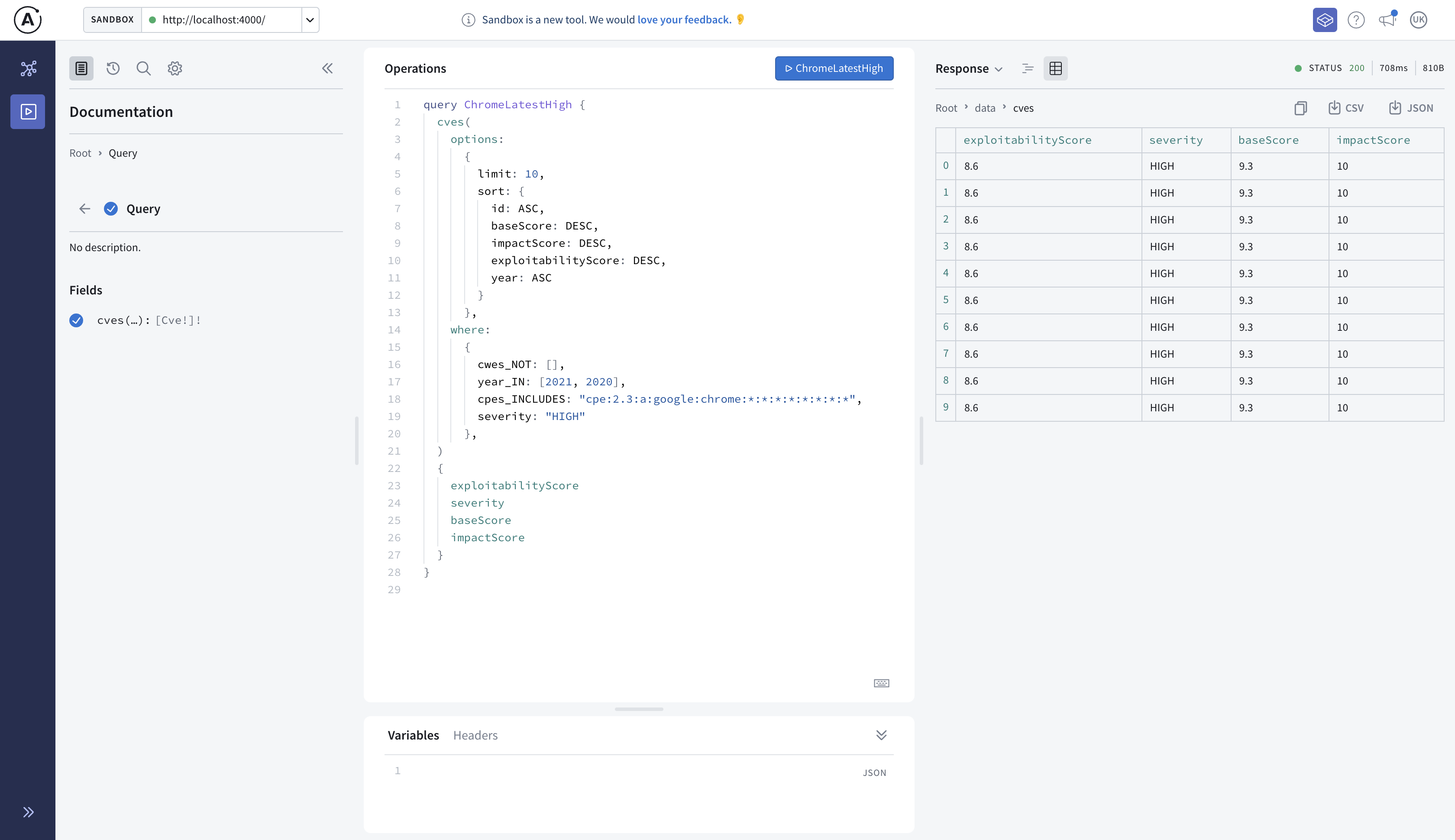@inspektre/vulnhub v0.1.31
__ __ _ _ _ _
\ \ / / | | | | | | | |
\ \ / /_ _ | | _ __ | |__| | _ _ | |__
\ \/ /| | | || || '_ \ | __ || | | || '_ \
\ / | |_| || || | | || | | || |_| || |_) |
\/ \__,_||_||_| |_||_| |_| \__,_||_.__/ (:Attackers)->[:THINK]->(:Graphs)<-[:SHOULD_THINK]<-(:Defenders)
Convert NVD CVEs into Graphs
To-Do
- Add CPEs to the seeding process.
- @neo4j/graphql@2.0.0-alpha offers relationships in the beta library where connections to nodes can be made easily. This feature is soon to be realized with CPEs and CVEs
What is CVE?
Please visit MITRE at https://cve.mitre.org/ to read more about what CVEs are. Below is a quick gist in two sentences.
- Common vulnerabilities & Exposures (CVEs) is a list of publicly disclosed computer/software/hardware security flaws, including security advisories from vendors.
- The format is CVE-YYYY-XXXXX and can be interpereted as a sequence in a given year starting from 2002.
Installation
To install vulnhub as CLI, Please ensure to use either npm or yarn package managers.
yarn:yarn global add @inspektre/vulnhub.npm:npm i -g @inspektre/vulnhub
Getting Started
To get started, visit the wiki section.
Apollo Studio
To start the GraphQl server, type:
- In Production mode:
vulnhub serve - In Development mode:
./bin/run serve

Prerequsities
- Nodejs v14+
- Yarn or npm to install JavaScript dependencies.
- Neo4J Database!
Development mode
- To install dependencies, type
yarn run. - To run GraphQL Server, type
yarn start. - To seed database with CVEs, type
yarn seed.
Environment variables
The name of the database can be anything string. However, nvd is the most appropriate.
NEO4J_URI=bolt+s://<IP/FQDN>:7687
NEO4J_USER=<username>
NEO4J_PASSWORD=<pwd>
NEO4J_DATABASE=nvd
BASE_DIR=/home/vulnhub/feeds/cveWhy Neo4J
obs=(:Graphs)-:ARE-(:Everywhere) RETRUN obs; Graphs make it more intuitve in searching for patterns, establishing relationships as first-class citizens instead of Foreign Keys Primary Keys. Creating CVE Knowledge Graphs is the goals of this project for collective public benefit.
Setting up Neo4J Database.
There are many-a-ways for getting started with your neo4j database. Below are recommendations, please choose an option that best suits your needs.
- Ensure that you have at-least 4 GB of storage with Neo4j Aura (Neo4J DBaaS). Theisfastest way is to get started (https://console.neo4j.io/#databases). As the CVE database is way beyond the free-tier limits. However Aura is reasonably priced.
- Spin-up a Neo4j community edition server on Azure, AWS or GCP compute.
- Spin-up a compute on alternate cloud-server providers (upcloud | DO | vultr | linode and etc.).
With options 2 & 3, Please ensure to do the following: (Based on upcloud tests)
- Spin up compute with at-least 16 GB Memory and 4 vCPUs.
- Perform seeding with
yarn seed(Takes about 45 seconds) - Spin down the compute and downgrade to at half the capacity for acceptable daily-use.
Database memory & configuration
Neo4J Memory configurations below are for reference. Overall, having Neo4j (Preferrably any linux distro) with at least 32 GB Memory with 6 vCPUs has significant seeding performance. Additionally, neo4j can be deployed to a kubernetes for theoritical unlimited scalability for your CVE Graphs.
dbms.memory.heap.initial_size=1g
dbms.memory.heap.max_size=6g
dbms.memory.pagecache.size=8g
dbms.memory.transaction.global_max_size=4g
dbms.memory.transaction.max_size=2gDuring seeding, a significant amount of memory is used to quickly create relationships between nodes. Once the seeding is complete, relationships will be continually evaluated for delta and hence our rationale in recommendations to use these
inspektre knowledge-graph
- As inspektre does not manage public database, Knowledge Graphs for NVD is not being shared.
- Some of the calls made require full access to the database to run graph algorithms.
- Until full automation can be reached and a unanimous decision is reached on components we want to make available for the benefit of the community, the knowledge graph call is exposed but for inspektre & inspektre customer use.
Need help?
If you need help with this project, please do create an issue. We will help you on a best-effort basis.
History
Vulnhub started originally in Nov 2016 as part of a programming-assignment for a job-interview. The interview was successful but the code-base was left abandoned. The whole code-base was over-engineered in Python.There were minor updates between 2017 through 2019. The original database of choise was postgresql & python with SQLAlchemy as the ORM. NodeJS, GraphQL and Neo4j (Based off grand-stack) were introduced in 2020.
Special note of thanks. Adam Heczko helped restore ownership in 2019. The repository is now back to the right owner and is being maintained under the Aegis of inspektre.
4 years ago
4 years ago
4 years ago
4 years ago
4 years ago
4 years ago
4 years ago
4 years ago
4 years ago
4 years ago
4 years ago
5 years ago
5 years ago
5 years ago
5 years ago
5 years ago
5 years ago
5 years ago
5 years ago
5 years ago
5 years ago
5 years ago
5 years ago
5 years ago
5 years ago